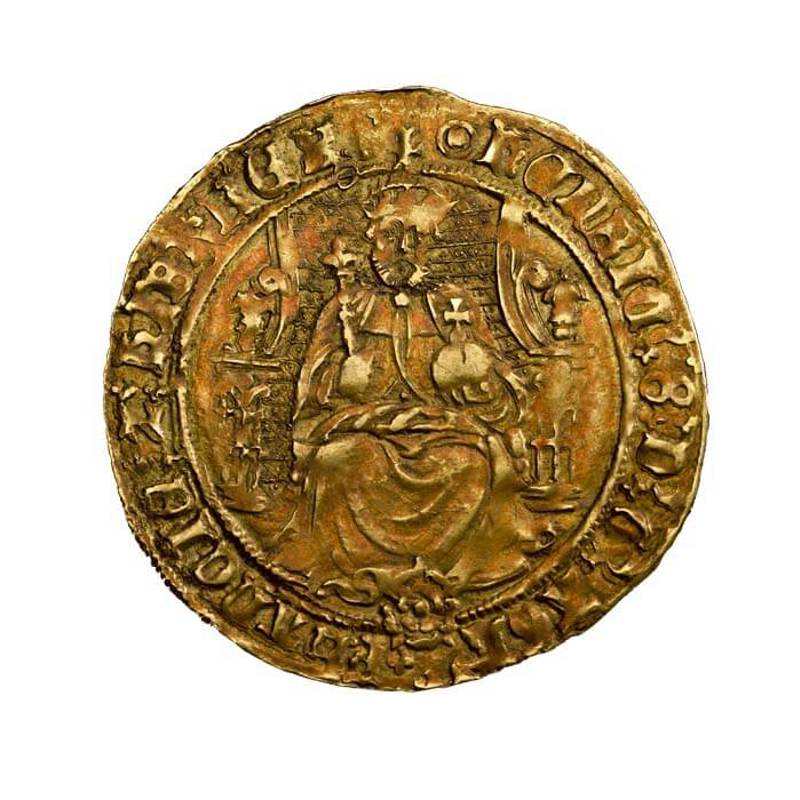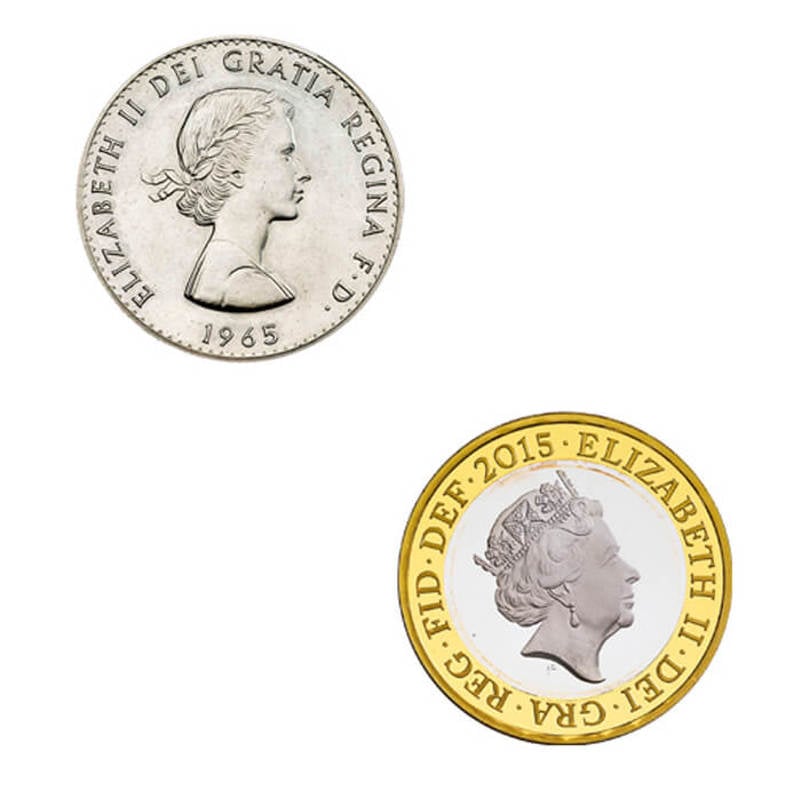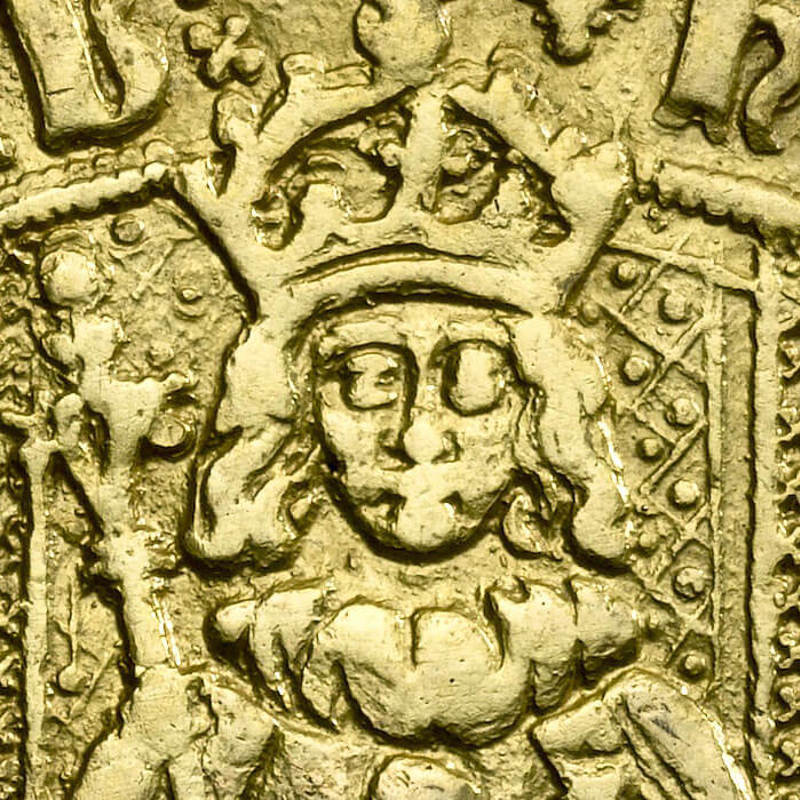Tudor Sovereign
Fine gold: Henry VII type 1
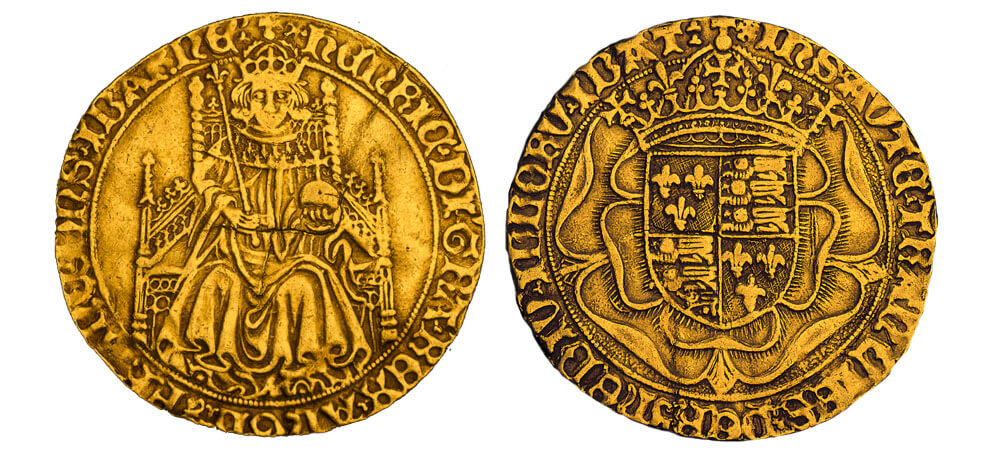
The designs for all sovereigns struck in fine gold consist of an enthroned portrait and a shield of the Royal Arms set against a Tudor rose. But the first issue of 1489, of which only a couple of specimens are known to survive, is highly distinctive - both for the simple background on the obverse and the large crown above the shield on the reverse.
More so than any later types, the first sovereign bears a striking resemblance to the real d'or - a gold coin issued in 1487 in the Netherlands. It may be that the Dutch coin served as the prototype for the sovereign, or it may be that the real d'or and the sovereign were both inspired by contemporary Spanish gold coins.
Fine gold: Henry VII type 2
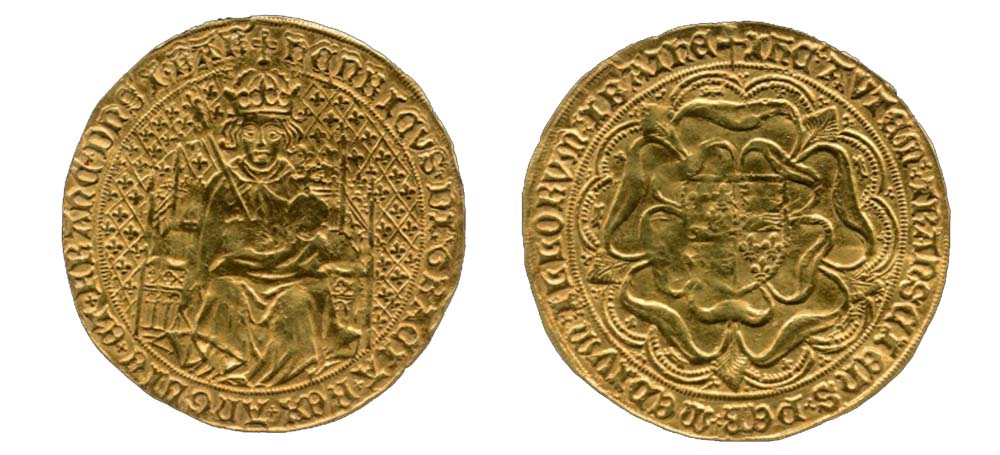
In the past it has been broadly accepted that the sovereign of the second type, with its field liberally scattered with fleurs de lys, was struck in connection with the French expedition of 1492. But this seems less likely in the light of recent work.
Fine gold: Henry VII type 3
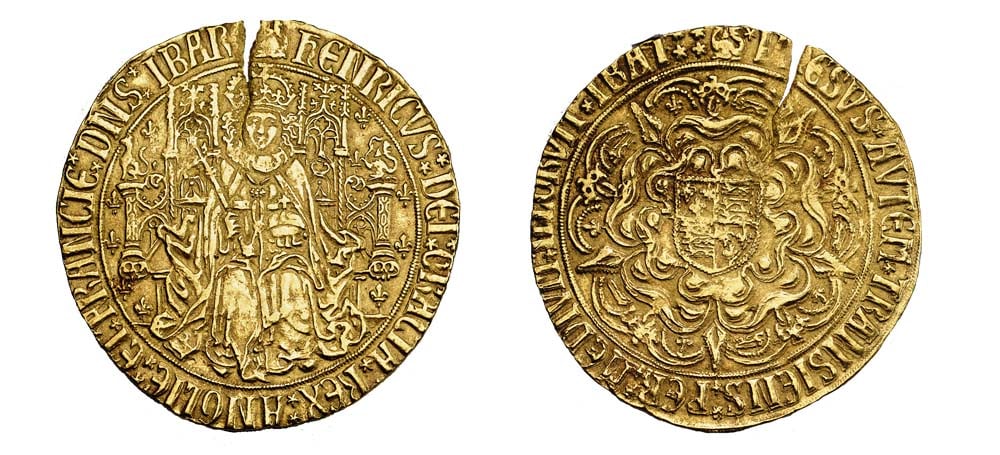
Perhaps the most distinctive features of the third type are the greyhound and dragon standing on the pillars of the throne. The dragon was Henry's badge at the battle of Bosworth Field and is said to have been the ensign of Cadwaladr, 'the last king of the Britons', from whom Henry claimed descent.
Fine gold: Henry VII type 4
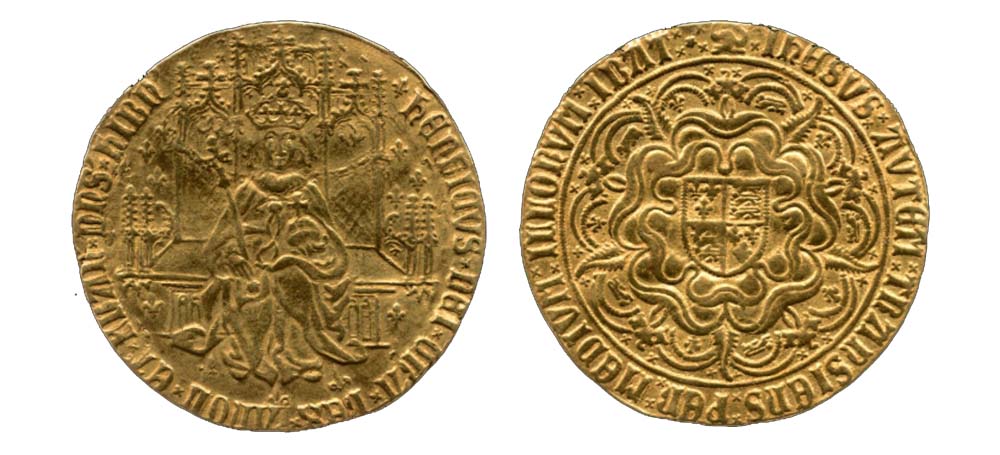
Coins of the fourth type, all struck from a single pair of dies, are the least rare of Henry VII sovereigns.
Fine gold: Henry VII type 5
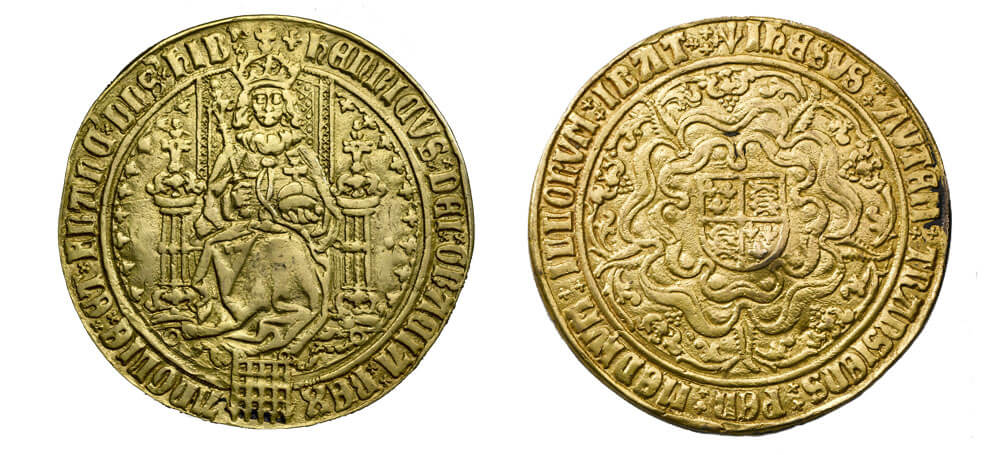
The portcullis of the House of Beaufort, a symbol of the Tudor dynasty, was inserted below the enthroned portrait on the fifth type. Henceforth, the basic lay-out of the design would change very little on the fine sovereigns of Henry VII's successors.
Fine gold: Henry VIII
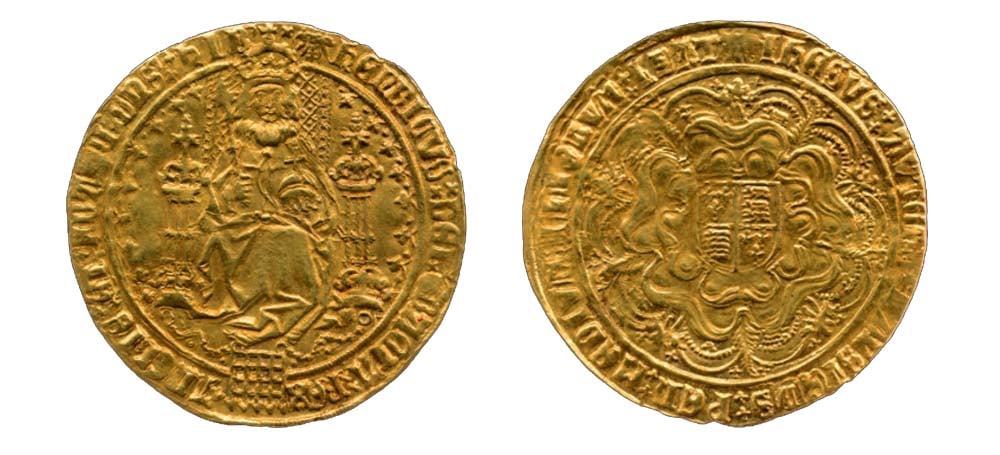
A unique sovereign of Henry VIII with a mintmark showing the sun breaking through clouds survives in the British Museum. Numismatists have long suspected that this highly distinctive mintmark, located at the start of the inscription on both sides of the coin, may be in some way connected with the birth of Henry's long-awaited son on 12 October 1537.
Fine gold: Edward VI
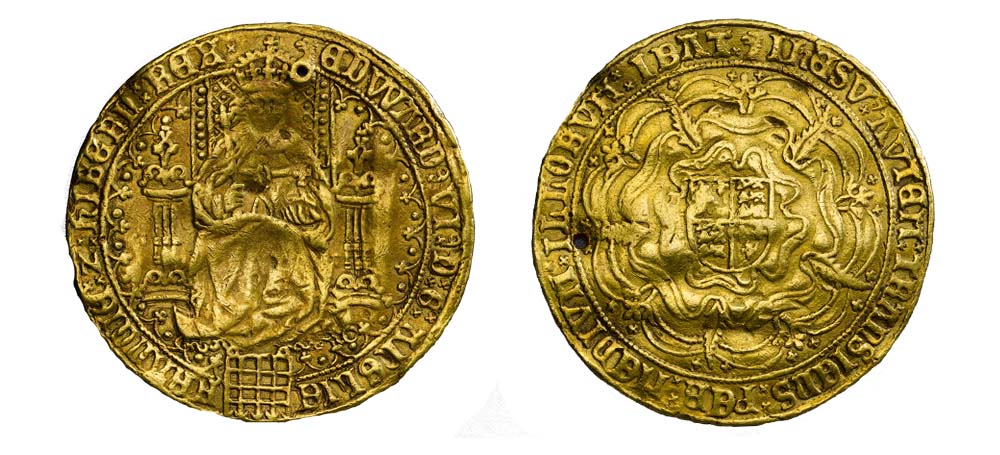
An extreme rarity held in the Royal Mint Museum is a double sovereign of the special Southwark issue of 1551. In essence, the coin is a piedfort - of double weight but standard diameter. The assumption is that these double sovereigns were intended as especially prestigious presentation pieces.
The only other Tudor sovereign of which piedforts are known is the final type of Henry VII.
Fine gold: Mary I
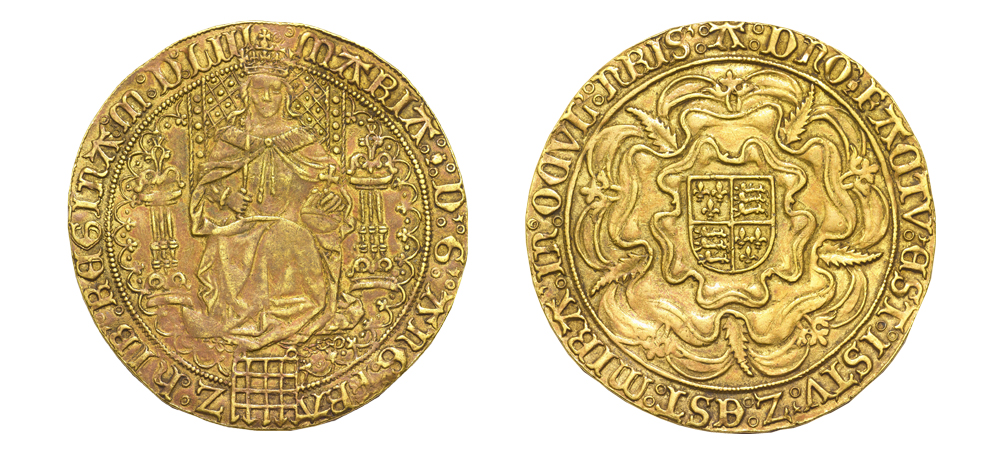
A number of the sovereigns issued by Mary I bear the date 1553 or 1554 in roman numerals at the end of the obverse inscription. They are the only Tudor sovereigns to be dated.
Fine gold: Elizabeth I
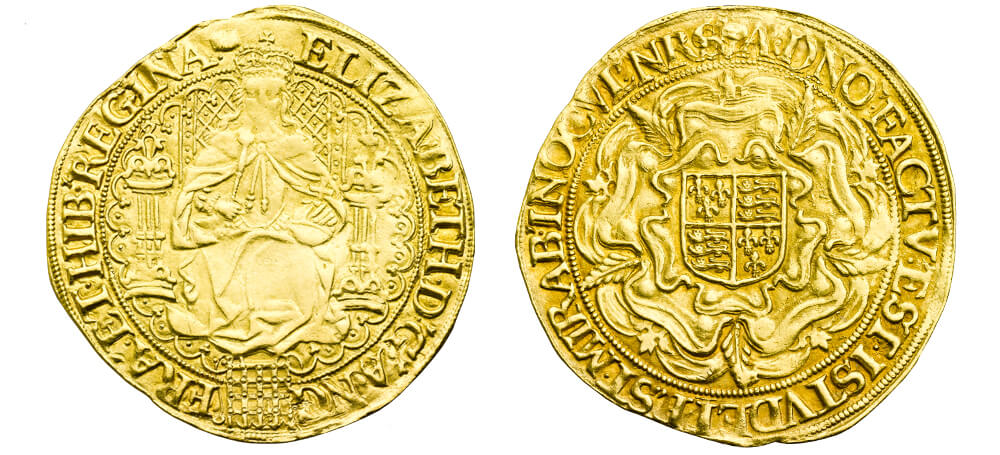
On many of the later sovereigns of Elizabeth I, the tressure surrounding the portrait continues up to the queen's head rather than stopping at the sides of the throne. Although this change may seem inconsequential, it attracted full-throated criticism from one numismatist in the 1930s who described the result as being 'both inartistic and incorrect...[as] the tressure is made to pass between the Queen's head and the back of her throne!'
Sovereign issues of the Great Debasement
| Issued | 1544-50 |
|---|---|
| Face value | 20 shillings |
During the Great Debasement, sovereigns were issued at four different standards.
|
|
Standard 1 |
Standard 2 |
Standard 3 |
Standard 4 |
|
Issue dates |
1544-45 |
1545-46 |
1546-47 |
1549-50 |
|
Weight |
12.96g |
12.44g |
12.44g |
10.98g |
|
Fineness |
23 carat (958) |
22 carat (916) |
20 carat (833) |
22 carat (916) |
Debasement: Henry VIII type 1
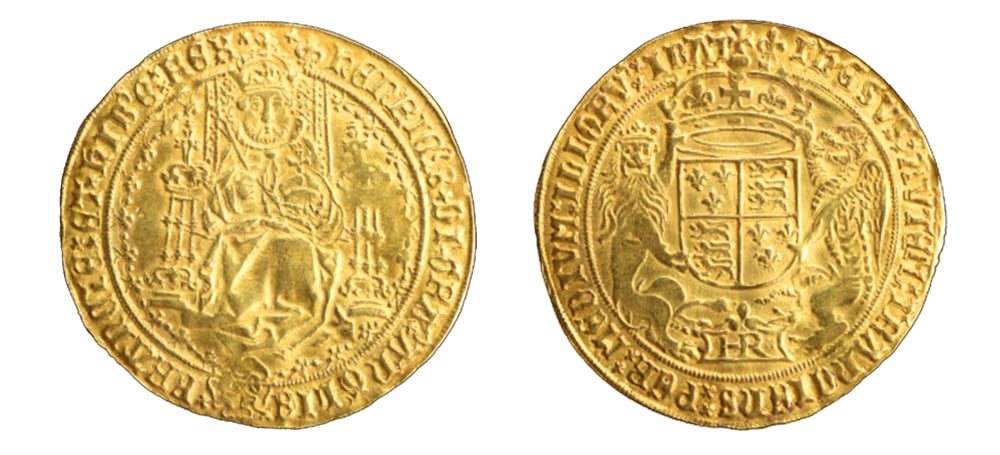
For the debasement sovereigns, the traditional shield-on-rose reverse design was abandoned in favour of a shield of the royal arms with lion and dragon supporters, with a monogram HR in a panel below.
Debasement: Henry VIII type 2
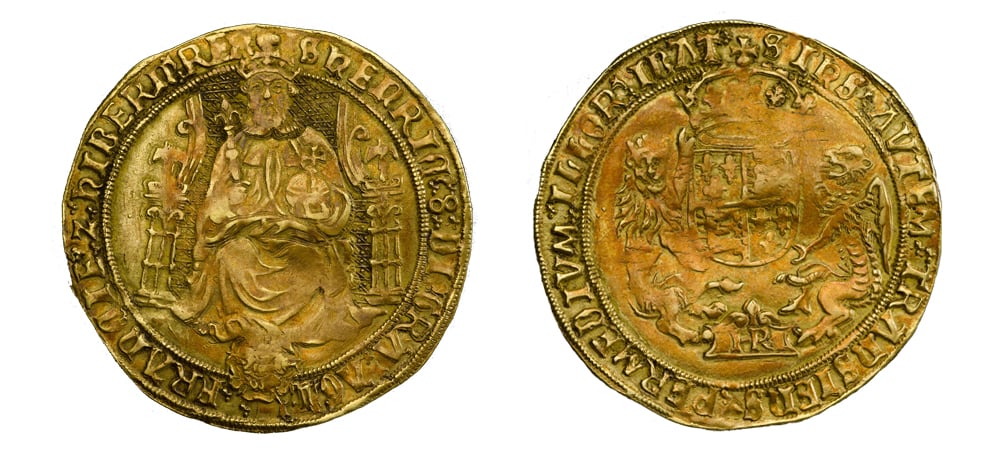
A slight reduction in the diameter of the coins in 1544 required some modification of the design, most obviously the removal of the tressure surrounding the enthroned portrait.
Debasement: Edward VI
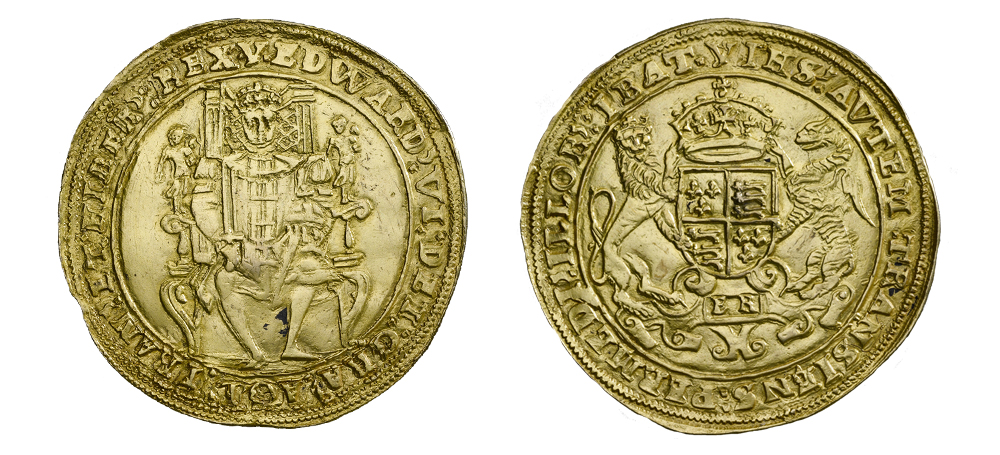
While retaining the enthroned portrait, the sovereigns of Edward VI are distinctive for showing the king wearing doublet and hose instead of robes, and holding a sword innstead of a sceptre.
Sovereigns struck in crown gold after the Debasement
|
Issued |
1551 – 1604 |
|
Face value |
20 shillings |
|
Weight |
1551-1601 11.31g 1601-1604 11.14g |
|
Fineness |
916 gold |
Post-debasement: Edward VI
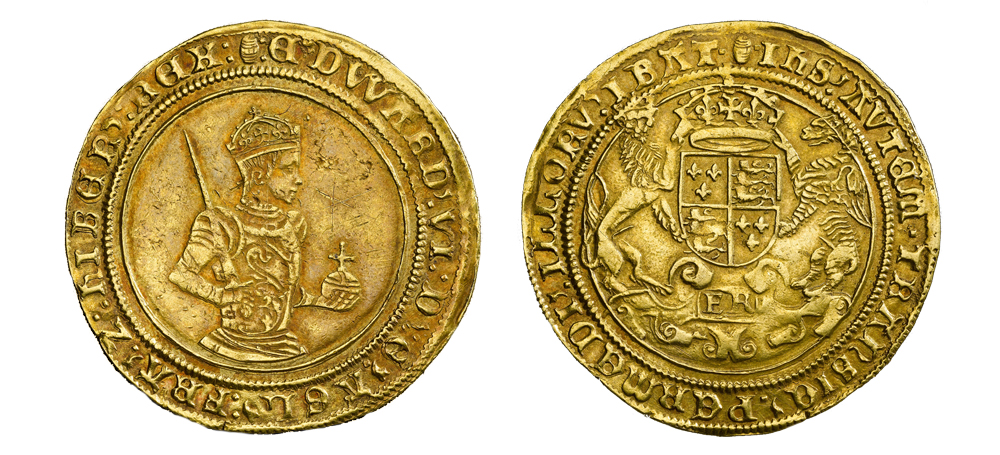
Bearing a half-length portrait, the crown gold pieces of Edward VI are the first sovereigns not to carry an enthroned effigy of the monarch.
Post-debasement: Elizabeth I
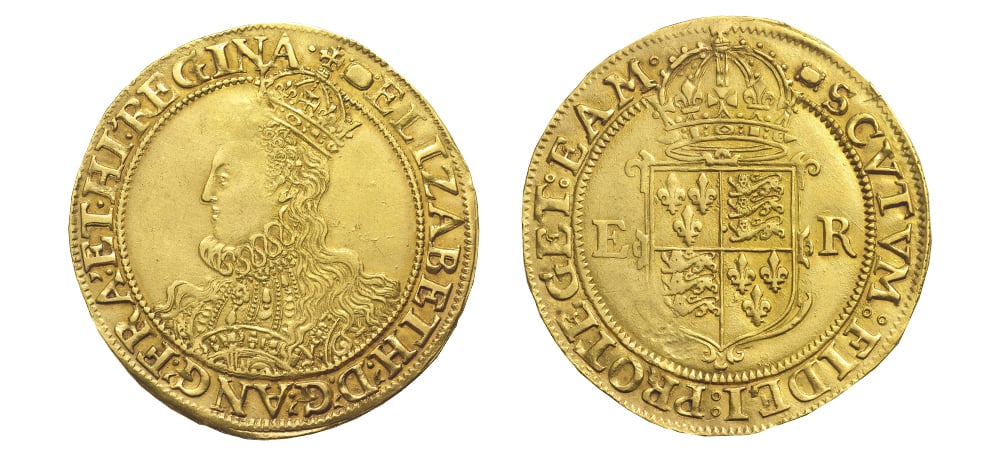
A remarkable portrait of the queen with long, flowing hair and a highly ornamented dress appears on the crown gold sovereigns of Elizabeth I.
Post-debasement: James I
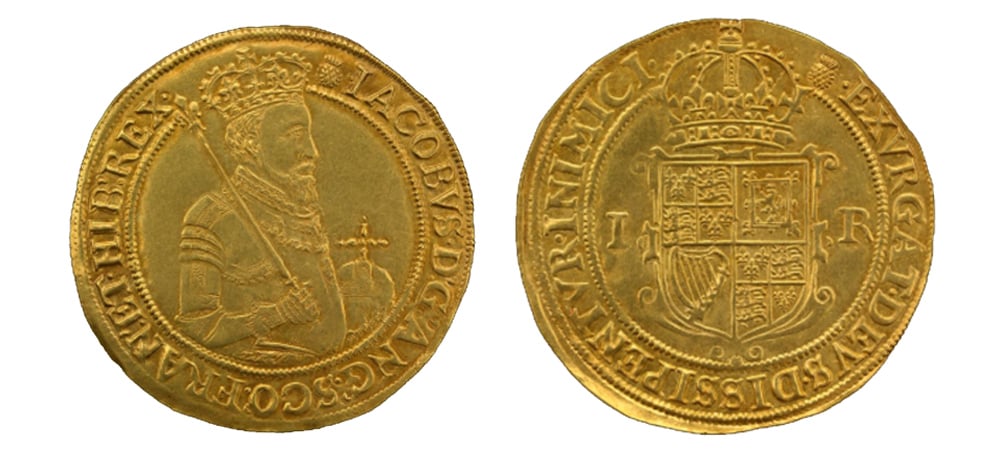
With the accession of the Stuart dynasty, the Royal Arms were amended to incorporate the Scottish lion rampant and the Irish harp in the second and third quarters.
The images on this page are from the Royal Mint Museum except for the following which are (c) Trustees of the British Museum: Fine gold, Henry VII type 1; Henry VII type 2; Fine gold, Henry VII type 4; Fine gold, Henry VIII; Debasement, Henry VIII type 1; Post debasement, James I
Below you can find more information on the history and specifications of Tudor sovereigns.
1489
With its enormous size and magnificent designs, the new sovereign constituted a remarkable addition to the English coinage. For the first time the pound sterling, in use for centuries as a denomination of account, was given material expression in the shape of a single coin. For all that the sovereign may have performed some economic function as a large and impressive store of wealth, it is unlikely there was a genuine monetary need for a piece of such high value. The main stimulus for the new coin was probably political, the purpose being to add lustre both at home and abroad to the image of the new Tudor dynasty. Indeed the sovereign may well have appeared in 1489 precisely because it was in that year the Tudors gained effective international recognition in the Treaty of Medina del Campo – by which Henry VII’s son and heir, Arthur, was to marry a Spanish princess. The sovereign was probably intended, to some extent at least, to serve as a presentation and ceremonial piece. Certainly there are two cases recorded of sovereigns being used as diplomatic gifts: the first from May 1502 when 16 pieces were given to ambassadors from Hungary; the second from February 1506 when 40 pieces were presented to members of the household of the king of Castile.
1489-1509
There are five different types of Henry VII’s sovereign and the denomination seems to have been coined periodically through the reign on a limited scale, even if perhaps an original provision that two were to be struck from every pound of gold may not always have been carried out.
1509-44
Sovereigns were issued as part of the first and second coinages of Henry VIII but production seems not to have been continuous. In particular, it seems that no sovereigns were produced in the decade or so after 1526.
1526
The sovereign was revalued first to 22 shillings, then 22s 6d, as part of a currency reform engineered by Cardinal Wolsey intended to align the values of English coins with those from the Continent.
1544-51
In a shocking episode seen neither before nor since, the Great Debasement witnessed the systematic exploitation of the coinage for the profit of the crown. Gold was not so badly affected as silver but nevertheless the worst debased gold coins contained in effect only three-quarters of the gold in pre-debasement issues. Temporary mints were opened to facilitate the debasement. In addition to the Tower, debased sovereigns were struck at establishments in Southwark and at Bristol Castle. Apart from the special issue referred to below, all sovereigns struck during the debasement were denominated at 20 shillings.
1551
In the first half of the year, a small number of sovereigns of pre-debasement weight and fineness were struck at the Southwark mint. Formally denominated at 24 shillings, the coins would have been significantly undervalued for the purposes of circulation. But the strong suspicion is that this issue was intended for the personal use of the king. The policy of debasement was finally abandoned in October 1551.
1551-53
Two different coins bearing the name of sovereign were struck in the latter part of Edward VI’s reign: a fine sovereign at the pre-debasement standard, essentially the same as the special issue of early 1551 except that the coins were now denominated at 30 shillings; and a smaller sovereign in crown (22 carat) gold with a value of 20 shillings.
1553
The seventeenth-century diarist, John Evelyn, appears to provide an example of sovereigns being used in a ceremonial context. In his 1697 work, Numismata, he records that ‘Ryals of broad gold’ were scattered at Mary I’s coronation – but his illustration and the accompanying description are clearly of a sovereign rather than a fifteen-shilling ryal.
1553-55
Fine sovereigns were issued by Mary I.
1558-62
Fine sovereigns were issued by Elizabeth I.
1584-c.1593
Fine sovereigns were struck for the last time, although it should be noted that the coins were formally described in the authorising commission as ‘double nobles’. Up until 1587 at least, the coins produced were apparently intended for circulation in the Netherlands – where the premium paid on English fine gold coins resulted in a small profit.
1593
After an absence of forty years, the crown gold sovereign was revived in June 1593. Henceforth a coin of 20 shillings (or thereabouts) would remain a regular part of mint output.
1601
The weight of all coins was slightly reduced to accommodate a modest increase in the mint price for bullion.
1603-04
The crown gold sovereigns issued at the start of James I’s reign were the last coins to bear the name for more than two centuries. Gold coins of 20 and 30 shillings were issued in the years that followed – but they were now known as unites and rose ryals.
Specifications and design
For the sake of clarity, issues of the Tudor sovereign can be usefully divided into three groups: sovereigns struck in fine (995) gold; sovereign issues of the Great Debasement; ad sovereigns struck in crown (916) gold after the Debasement.
The tables below provide images of every major design type of the Tudor sovereign.
View list of inscriptions and their translations
IHESUS AUTEM TRANSIENS PER MEDIUM ILLURUM IBAT
But Jesus, passing through the midst of them, went His way (Luke 4:30)
A DOMINO FACTUM EST ISTUD ET EST MIRABILE IN OCULIS NOSTRIS
This is the Lord's doing and it is marvellous in our eyes (Psalms 118:23)
SCUTUM FIDEI PROTEGET EAM
The shield of faith shall protect her
EXURGAT DEUS ET DISSIPENTUR INIMICI EIUS
Let God arise and let His enemies be scattered (Psalms 68:1)
Sovereigns struck in fine gold
|
Issued |
1489 – c.1593 |
|
Face value |
1489 - August 1526 20 shillings August - November 1526 22 shillings November 1526 - 1551 22 shillings 6 pence From 1551 30 shillings |
|
Weight |
15.55g |
|
Fineness |
995 gold |
You might also like
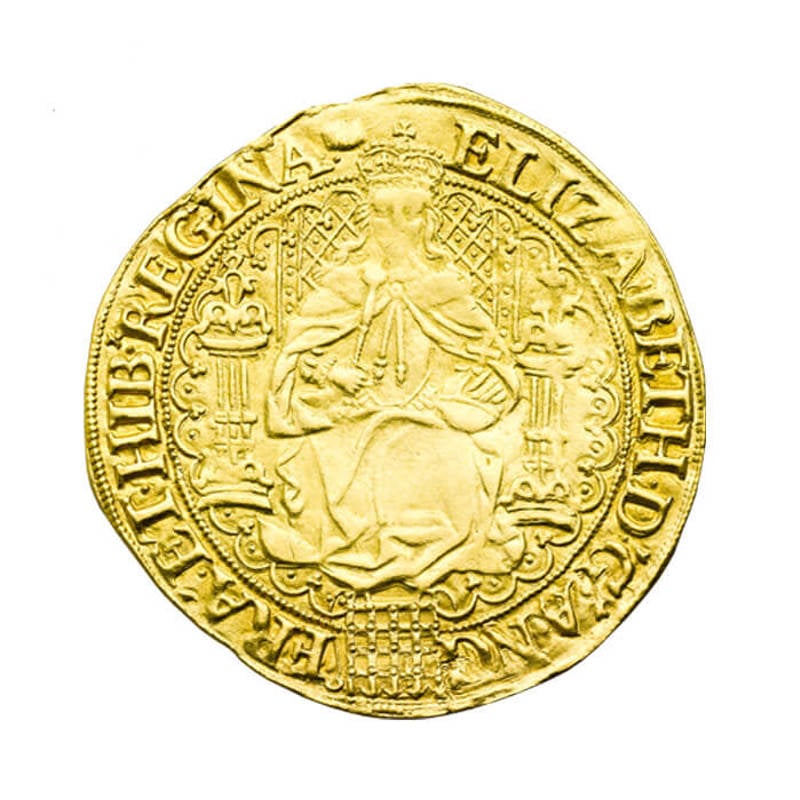
Elizabeth I fine sovereign
The fine sovereign of Elizabeth I pictured here was purchased from Lincoln for the Royal Mint Museum on 9 February 1914.

